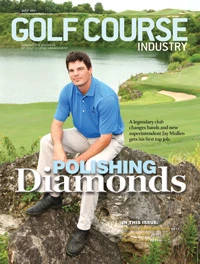With the golf season well underway and championship golf on everyone’s mind, the fourth major of the year – the 2011 PGA Championship – is being contested at The Atlanta Athletic Club where long-time friend Ken Mangum, CGCS, is preparing for his fifth big-time event. Recently, I had time to catch up with Ken and see where he and the course stand entering the final months of preparation.
Q: Where are you and the golf course at this stage?
A: While we were happy to see spring this year, the south really did not get its usual warming temperatures. We suffered from a cold and extended winter which affected our Bermudagrass and zoysia turf. The cold temperatures lingered longer than usual, affecting the spring green-up we normally see. Also, we encountered a tremendous amount of spring dead spot (Ophiosphaerella sp.) on both Bermudagrass and zoysia. Trying to push the turf to have a growth response was difficult due to cold air and soil temperatures along with only an inch of rain in six weeks. As we entered June, things were better and moving along fine. You cannot push Mother Nature. The slow green-up was good for our annual club invitational as we achieved the “firm and fast” conditions our industry is currently embracing and the members loved it.
Q: You and The Atlanta Athletic Club have been at the forefront in converting to new turf cultivars, especially the hybrid Bermudagrasses for putting surfaces. Why?
A: The club decided to move to these turfgrasses for several reasons, primarily due to the difficult growing conditions of a Georgia summer when you are trying to maintain quality creeping bentgrass turf; also, hosting major championships at the Athletic Club in the month of August (PGA Championship in 2011, U.S. Amateur in 2014). The risks of having weak bentgrass entering August and the inherent championship conditioning requirements were too great. With the warm season turf we can provide challenging playing conditions for our members and tournament players throughout the year.
Our on-course turf cultivars are:
• Champion Bermudagrass for the greens on The Highlands and Riverside golf courses
• Diamond zoysia grass for teeing grounds and fairways, approaches and closely-mown areas.
• T-10 Bermudagrass for the primary roughs. The darker blue green color is a wonderful contrast to the Bermuda and zoysia.
These turfs provide the following features and attributes:
• USGA sub-profiles that allow water to move away from the upper portion and assist in firmness.
• Cultivation depends on weather. The more we cultivate, the better the turf responds. Sand topdressing is ongoing annually for speed and surface smoothness. We have found the more you manage the Champion Bermudagrass, the better it becomes for play.
• The putting green collars are also Bermudagrass and they hold up very well, eliminating hand-syringing during play and the need for fans on our poorer green surrounds.
• The Champion Bermudagrass provides members with a longer period of good playing quality.
• If there is a downside it would be from a longer winter period and covering and uncovering during our “offseason.” However, the covers allow us – in many instances – to start play by 9:30 a.m. most winter mornings.
Q: This is your second PGA Championship. Anything different this time around?
A: First, The Highlands Golf Course is totally different than 2001. The club commissioned Rees Jones to re-do The Highlands and it has become a very tough championship golf course. The changes are as follows:
• The fairway bunkers have been re-positioned from 240 to 270 yards from the tees to 280 to 340 yards. Rees also deepened the bunkers for a difficult recovery effort.
• The additional depth required more drainage lines and catch basins for water diversion.
• All the grass types have been changed as discussed.
• Teeing grounds have been moved and re-positioned on slightly sharper angles to the landing zones.
• The gallery space surrounding each teeing ground has been expanded to allow for better viewing and walking space.
Off the golf course the following has occurred:
• Parking lots and hospitality areas moved and expanded. In addition, each is supplied with water, cable and power.
• The practice teeing ground has been rebuilt.
• The turf grass volunteers have been limited as we gave priority to those former maintenance staff members, assistants and interns. We wanted to make it a “homecoming” of sorts for those who gave their “sweat equity” and know the golf courses and grounds well.
Q: You have had an extended and great career in our industry. What words of wisdom would you pass along to those entering and looking forward to a similar run?
A: I like the word “extended!” For many people, golf has become bogged down due to the time factor. I would continue to look for ways to put the fun back into our great game. We are not all like Tiger Woods and many people who play take too much time trying to be that way.
I have seen the industry go from the over-the-top development which created golf courses which were too hard to play and certainly too hard to maintain. This is not the way to go about it.
When building courses, the goal should be to retain members, players and guests so they come back and play again tomorrow. If I built a course I would manage maintenance efforts by reducing vegetation, have fewer bunkers, wider fairways, less severe slopes to maintain and play on and a sustainable golf course with slightly lower expectation for conditioning and playing time.
For those young people in our profession I suggest they have patience. Our game is in a downward spiral, so job opportunities, construction of new facilities and upward movement will be slow. Eventually, it will come back, but it will take time. In the interim, study hard, learn from those who have gone before you and take every opportunity to advance your personal education and training, whether agronomically-geared or not. Even at this stage of my career and life I am always looking to improve and strengthen my weaker non-turf related knowledge. Clubs are looking for individuals who are not only strong in turf grass but also in finance, communication, public relations and politics.
Finally, stay and act young. There is an expression here in the south, “the grits trees keep you young.”
Are you listening, Ed Walsh?

Explore the July 2011 Issue
Check out more from this issue and find your next story to read.
Latest from Golf Course Industry
- Turfco introduces riding applicator
- From the publisher’s pen: The golf guilt trip
- Architect Brian Curley breaks ground on new First Tee venue
- Turfco unveils new fairway topdresser and material handler
- Ignite Attachments adds new box plane and grapple
- Mackenzie & Ebert working on new Caribbean course
- Keswick Hall renovating Full Cry course ahead of big year
- The alpha wolf





